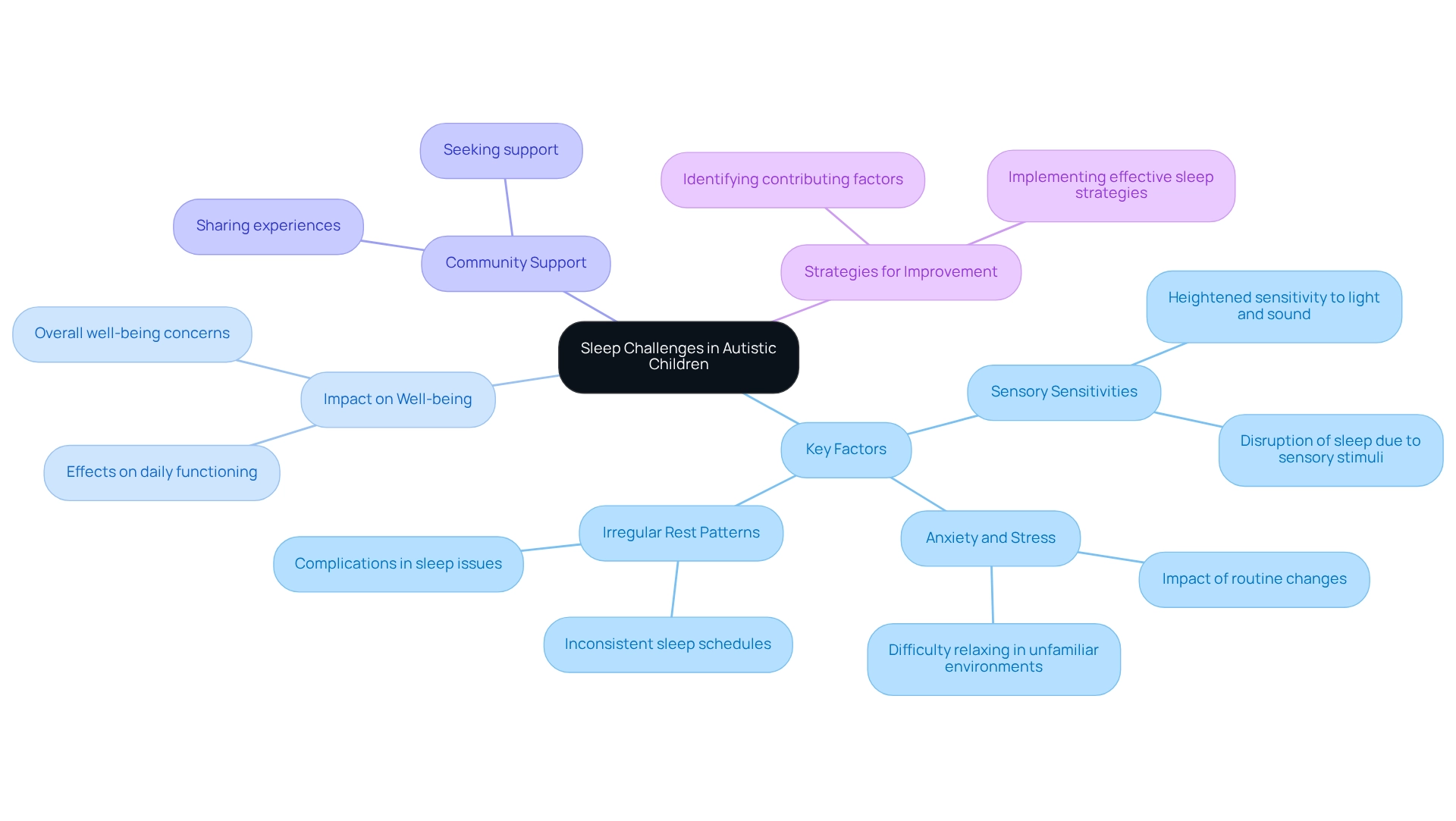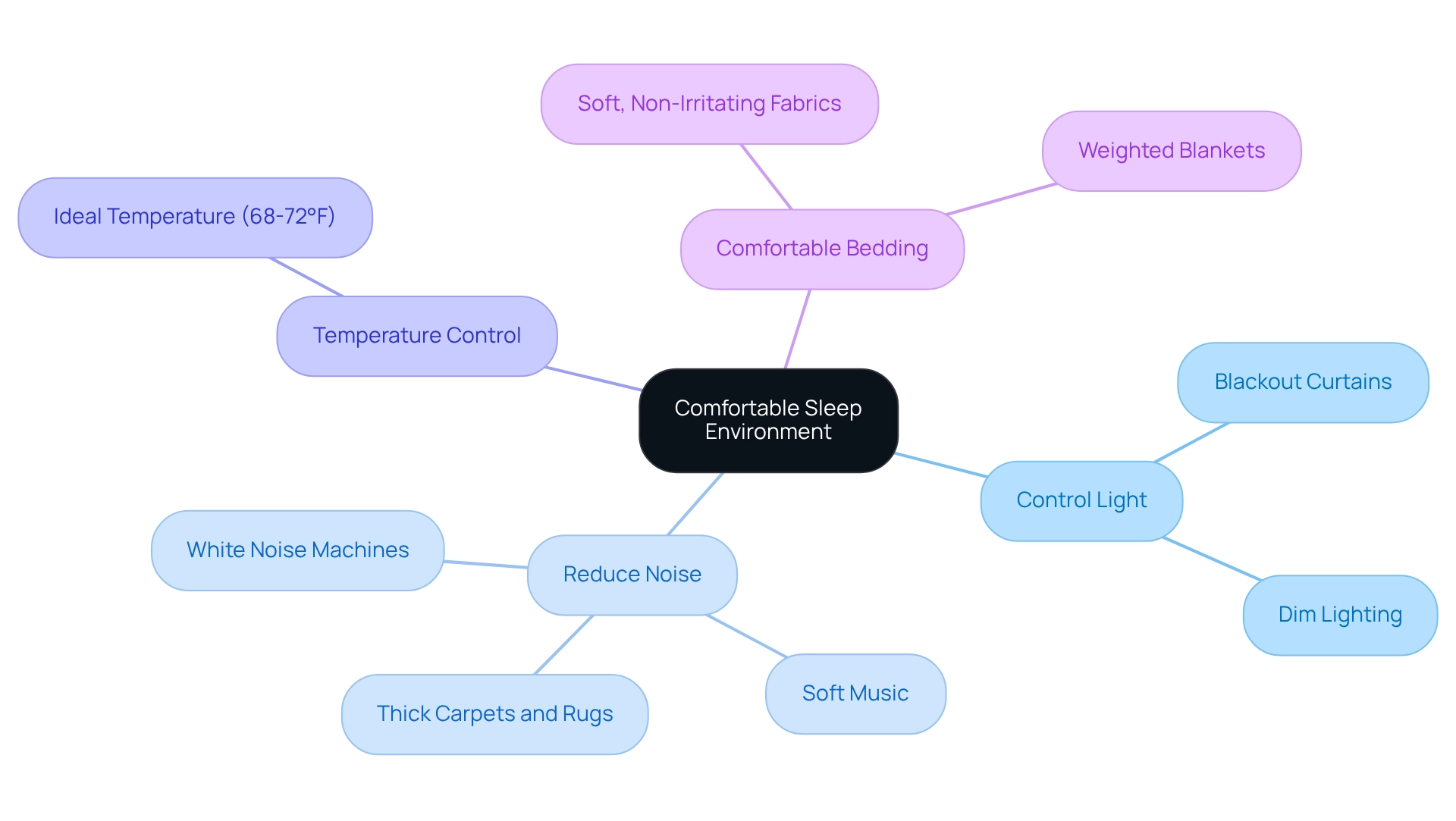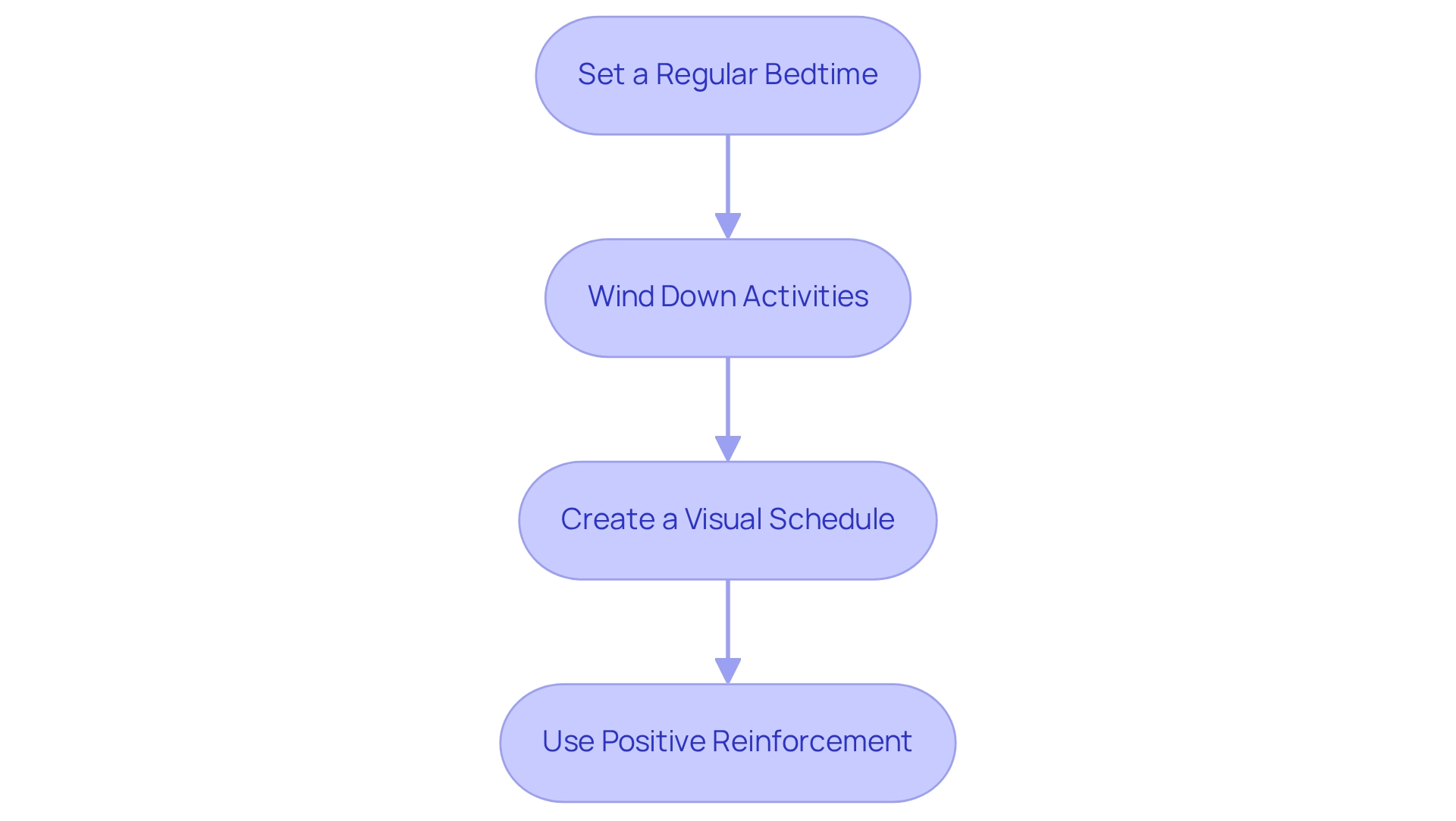Overview
To help your autistic child sleep better, it's essential to create a comfortable sleep environment, establish a consistent bedtime routine, and implement behavioral strategies that promote independent sleep. Many parents face challenges related to sensory sensitivities, anxiety, and irregular sleep patterns. By addressing these issues, you can significantly improve your child's sleep quality. Research shows that children with structured routines experience better rest outcomes, offering hope for families seeking solutions.
Consider starting with a calming bedtime routine that includes soothing activities, such as:
- Reading a favorite story
- Listening to soft music
These small changes can make a big difference. Remember, you are not alone in this journey; many parents share similar experiences. We encourage you to explore these strategies and connect with others who understand your concerns. Together, we can foster a nurturing environment that supports your child's sleep needs.
Introduction
Sleep is a vital component of overall health, yet for many autistic children, it remains an elusive goal. With sleep disturbances affecting a staggering 80% of this population, it is essential to understand the unique challenges they face. Factors such as:
- Sensory sensitivities
- Anxiety
- Irregular sleep patterns
can significantly hinder the ability to achieve restful nights. Parents and caregivers find themselves navigating these challenges, employing various strategies to:
- Create a conducive sleep environment
- Establish consistent routines
- Foster independence in sleep habits
This article delves into effective approaches that can help improve sleep quality for autistic children, ensuring they receive the restorative rest essential for their well-being and development. Together, we can explore these strategies and support our children in achieving better sleep.
Understand Sleep Challenges in Autistic Children
Families with children on the autism spectrum often face common concerns, including how to get an autistic child to sleep. These challenges often manifest as difficulties in falling asleep, frequent awakenings, or early morning risings. Understanding the factors that contribute to these sleep issues is essential for developing effective strategies on how to get an autistic child to sleep.
Key factors include:
- Sensory Sensitivities: Many autistic children experience heightened sensitivity to sensory stimuli, such as light and sound. This sensitivity can significantly disrupt their ability to fall asleep and stay asleep.
- Anxiety and Stress: Changes in routine or exposure to unfamiliar environments can trigger anxiety, making it difficult for young ones to relax and transition into rest.
- Irregular Rest Patterns: Inconsistent sleep schedules are common among young individuals on the spectrum, further complicating their sleep issues.
Research indicates that sleep issues are not only prevalent but can also be exacerbated by sensory sensitivities. Studies show that up to 80% of children with autism experience disturbances during the night. Additionally, having a sibling with autism raises the risk for autism spectrum disorder (ASD), which may contribute to sleep problems within these families. Addressing these challenges is crucial, as sleep-related difficulties can affect overall well-being and daily functioning.
As Carin Lamm, MD, wisely notes, "In summary, although issues related to sleep are frequent in youngsters with ASD, they often can be assisted." Identifying these factors is the first step toward implementing effective strategies for how to get an autistic child to sleep better. Furthermore, recognizing the under-diagnosis of autism is vital, as it may lead to an underestimation of the true number of individuals facing these challenges. By understanding and addressing these factors, you can better support your child in learning how to get an autistic child to sleep and attain restful slumber.
We encourage you to share your experiences or seek support in our community, as together, we can navigate these challenges and foster a more peaceful night’s rest for our children.

Create a Comfortable Sleep Environment
Understanding how to get an autistic child to sleep involves creating a comfortable sleep environment through several key adjustments that can make a significant difference in their well-being.
- Control Light: Implement blackout curtains to effectively block external light sources. A dim space signals to the brain that it is time to rest, which is essential for establishing a healthy sleeping routine. Research indicates that the total range of light intensity for the afternoon is 105 mW/m, underscoring the importance of minimizing light exposure during resting hours.
- Reduce Noise: Minimize disruptive sounds by utilizing white noise machines or playing soft music. Additionally, thick carpets and rugs can absorb sound, further enhancing the tranquility of the space.
- Temperature Control: Maintain a cool and comfortable room temperature, ideally between 68-72°F (20-22°C), to encourage restful sleep.
- Comfortable Bedding: Opt for soft, non-irritating fabrics for bedding and pajamas. For some children, weighted blankets can provide a soothing sense of safety, aiding in relaxation.
These modifications can create a soothing environment that promotes relaxation and enhances sleep quality, which is crucial when learning how to get an autistic child to sleep, ultimately benefiting your child's overall well-being. As Mary Barbera wisely states, 'Embrace the amazing gift of autism,' reminding us of the unique strengths and needs of our young ones. Additionally, creating a supportive environment, as explored in the case study "Enhancing Social Skills in Autistic Children," can further contribute to their comfort and well-being.

Establish a Consistent Bedtime Routine
Establishing a consistent bedtime routine for autistic children is a nurturing approach when considering how to get an autistic child to sleep and support their overall well-being. Here are some essential steps to consider:
- Set a Regular Bedtime: Designate a specific bedtime each night and stick to it, even on weekends. This consistency is vital for managing the body's internal clock, significantly enhancing the quality of rest. Research shows that children with regular sleeping hours enjoy 30% improved rest quality compared to those who lack such routines.
- Wind Down Activities: Incorporate calming pre-bedtime activities like reading, listening to soft music, or practicing deep breathing exercises. It's important to steer clear of stimulating activities, especially screen time, as they can hinder the transition to sleep.
- Visual Schedule: Create a visual schedule that clearly outlines the evening routine. This tool can help your child anticipate what comes next, reducing anxiety and making the transition smoother. Dr. Emma Baker emphasizes the importance of reliable resources, stating, "Our content is regularly reviewed for quality and currency."
- Positive Reinforcement: Use praise or small rewards to encourage your child to engage in the evening routine. This approach not only motivates participation but also fosters a sense of accomplishment.
Studies have shown that an organized nighttime routine can lead to better sleep outcomes for young ones, ultimately boosting their overall well-being. Experts highlight that knowing how to get an autistic child to sleep can lead to consistent sleeping hours, which are linked to improved sleep quality and are particularly beneficial for autistic youth who may experience sleep challenges. By implementing these steps, parents can create a more enjoyable nighttime routine, supporting their children's development and emotional health. Furthermore, case studies reveal that young individuals who follow a regular bedtime routine often display enhanced communication skills, allowing them to express their needs and emotions more effectively.

Implement Behavioral Strategies for Independent Sleep
To foster independent sleep in your child, consider implementing some nurturing behavioral strategies that can truly make a difference:
-
Gradual Withdrawal: Start by sitting with your child until they drift off to sleep. Each night, gently position yourself a little further from their bed, guiding them toward the comfort of falling asleep on their own. This method has proven effective for parents seeking how to get an autistic child to sleep independently. Notably, research indicates that significant improvements in behavior and social skills can occur in individuals diagnosed with autism spectrum disorder (ASD) from the age of four and onward, emphasizing the importance of early intervention.
-
Self-Soothing Techniques: Equip your little one with self-soothing strategies, such as deep breathing exercises or cuddling a favorite stuffed animal for comfort. Studies suggest that these techniques can greatly enhance emotional regulation and foster better sleep habits. Insights from the case study "Building Emotional Self-Awareness in Individuals with Autism" underscore the necessity of developing emotional self-awareness as a foundation for effective emotional regulation, empowering your child to manage their feelings more effectively.
-
Bedtime Pass: Introduce a bedtime pass system, allowing your child to leave their room a limited number of times for specific reasons, like needing a drink of water or using the bathroom. This approach helps them feel secure while learning to stay in bed. Creating a supportive environment for self-soothing behaviors is vital, as community backing can enhance the effectiveness of this strategy.
-
Consistent Response: If your child gets out of bed, calmly return them to their room without engaging in lengthy discussions. Consistency in your response reinforces the expectation of staying in bed, which is essential for establishing a calming bedtime routine. Tailored therapies aimed at improving sleep may benefit all types of autism, especially when considering how to get an autistic child to sleep.
These approaches not only help your child develop essential skills for independent sleep but also pave the way for more restful nights for the entire family. As Laura NG, Clinical Operations Manager, wisely states, "Discover strategies for promoting neurodiversity in autism education," highlighting the importance of adapting methods to meet each child's unique needs.

Conclusion
Understanding and addressing the unique sleep challenges faced by autistic children is essential for enhancing their overall well-being. The prevalence of sleep disturbances—often made more challenging by sensory sensitivities, anxiety, and irregular sleep patterns—highlights the need for tailored strategies. By creating a comfortable sleep environment, establishing consistent bedtime routines, and implementing behavioral strategies, parents and caregivers can significantly improve sleep quality for their children.
Creating an optimal sleep environment involves:
- Managing light
- Controlling noise
- Regulating temperature
- Ensuring bedding comfort
These adjustments can foster a calming atmosphere that promotes relaxation and restful sleep. Additionally, a structured bedtime routine helps regulate the body's internal clock, while behavioral strategies encourage independence in sleep habits. This holistic approach not only aids in achieving better sleep but also supports emotional health and development.
In conclusion, prioritizing sleep for autistic children is a critical step toward ensuring their well-being. By employing effective strategies and understanding the underlying challenges, parents can empower their children to experience restorative rest. With improved sleep, children can thrive, enhancing their daily functioning and quality of life. Ultimately, the journey to better sleep is a collaborative effort that benefits the entire family, paving the way for a brighter future.
Frequently Asked Questions
What are common sleep challenges faced by autistic children?
Common sleep challenges include difficulties in falling asleep, frequent awakenings during the night, and early morning risings.
What factors contribute to sleep issues in autistic children?
Key factors include sensory sensitivities, anxiety and stress related to changes in routine or unfamiliar environments, and irregular rest patterns due to inconsistent sleep schedules.
How prevalent are sleep disturbances among children with autism?
Research indicates that up to 80% of children with autism experience disturbances during the night.
How does having a sibling with autism affect sleep issues?
Having a sibling with autism raises the risk for autism spectrum disorder (ASD), which may contribute to sleep problems within families.
Why is it important to address sleep challenges in autistic children?
Addressing sleep-related difficulties is crucial because they can significantly affect overall well-being and daily functioning.
What is the first step toward improving sleep for autistic children?
Identifying the factors contributing to sleep issues is the first step toward implementing effective strategies for better sleep.
What should families do to support their autistic child's sleep challenges?
Families are encouraged to share their experiences and seek support within their community to navigate these challenges and foster better sleep for their children.




